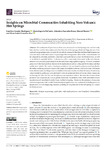Mostrar o rexistro simple do ítem
Insights on Microbial Communities Inhabiting Non-Volcanic Hot Springs
| dc.contributor.author | Escuder-Rodríguez, Juan-José | |
| dc.contributor.author | De Castro de Antonio, María Eugenia | |
| dc.contributor.author | Saavedra-Bouza, Almudena | |
| dc.contributor.author | Becerra, Manuel | |
| dc.contributor.author | González-Siso, María-Isabel | |
| dc.date.accessioned | 2023-01-09T20:32:44Z | |
| dc.date.available | 2023-01-09T20:32:44Z | |
| dc.date.issued | 2022-10-13 | |
| dc.identifier.citation | Escuder-Rodríguez, J.-J.; DeCastro, M.-E.; Saavedra-Bouza, A.; Becerra, M.; González-Siso, M.-I. Insights on Microbial Communities Inhabiting Non-Volcanic Hot Springs. Int. J. Mol. Sci. 2022, 23, 12241. https://doi.org/10.3390/ijms232012241 | es_ES |
| dc.identifier.issn | 1422-0067 | |
| dc.identifier.uri | http://hdl.handle.net/2183/32316 | |
| dc.description | The dataset of the metagenome supporting the conclusions of this article is available in the MG-RAST repository: https://www.mg-rast.org/linkin.cgi?project=mgp84238 (accessed on 3 October 2022). | es_ES |
| dc.description.abstract | [Abstract] The northwest of Spain has an abundance of non-volcanic hot springs that, until recently, had only been used for thermalism activities. One of such hot springs, Muiño da Veiga, has now been explored using metagenomics to study the microbial community that inhabits these high-temperature circumneutral continental waters. Sequencing of the metagenome allowed the characterization of its composition, diversity, metabolic connections and potential as a source for thermozymes, as well as its ability to assemble MAGs. A diverse microbial community dominated by Bacteria domain members was revealed, particularly from the early-branching Aquificales group. The most abundant genus was Sulfurihydrogenibium, known for its implication in sulfur cycling and for forming mats that enable novel niches. The variety of primary producers with autotrophic pathways (and specifically the sulfur oxidizing pathway) expands the range of available nutrients, and the increase in biomass forms thicker mats, resulting in more available niches and broader microbial diversity. Nonetheless, certain metabolic pathways were attributed to less abundant members of the microbial community, reinforcing the idea that the rare biosphere plays important roles in the network of interactions present in an ecosystem and acts as genetic reservoirs. In addition, three of the assembled MAGs represent novel microbial diversity found in this hot spring. Moreover, the presence of enzymes and microorganisms with possible biotechnological applications was confirmed, including proteases, lipases and cell-wall degrading enzymes, pointing to the potential for the hot spring as a source for thermozymes. | es_ES |
| dc.description.sponsorship | This research was funded by XUNTA DE GALICIA “Consolidación GRC” co-financed by FEDER, Grant Number ED431C 2020/08, and MINISTERIO DE CIENCIA, INNOCACIÓN Y UNIVERSIDADES (MICINN), Grant Number RTI2018-099249-B-I00. J.-J.E.-R. received a predoctoral fellowship from UNIVERSIDADE DA CORUÑA/INDITEX “Axudas para estadías predoutorais INDITEX-UDC 2016”, budget identification 0400470001 422D 48700. J.-J.E.-R. received a predoctoral fellowship from CENTRO DE INVESTIGACIONES CIENTIFICAS AVANZADAS/INSTITUTO DE INVESTIGACIÓN BIOMÉDICA DE A CORUÑA. “Agrupación CICA-INIBIC: ayudas para estancias pre y postdoctorales 2016”, budget identification 6100240002 541A 6490211 | es_ES |
| dc.description.sponsorship | Xunta de Galicia; ED431C 2020/08 | es_ES |
| dc.description.uri | https://www.mg-rast.org/linkin.cgi?project=mgp84238 | |
| dc.language.iso | eng | es_ES |
| dc.publisher | MDPI | es_ES |
| dc.relation | info:eu-repo/grantAgreement/AEI/Plan Estatal de Investigación Científica y Técnica y de Innovación 2017-2020/RTI2018-099249-B-I00/ES/PRODUCCION DIRIGIDA DE XOS PARA DISTINTAS APLICACIONES ALIMENTARIAS MEDIANTE TECNOLOGIAS ENZIMATICAS INNOVADORAS/ | es_ES |
| dc.relation.uri | https://doi.org/10.3390/ijms232012241 | es_ES |
| dc.rights | Atribución 4.0 Internacional | es_ES |
| dc.rights.uri | http://creativecommons.org/licenses/by/4.0/ | * |
| dc.subject | Shotgun sequencing | es_ES |
| dc.subject | Aquificales | es_ES |
| dc.subject | Sulfurihydrogenibium | es_ES |
| dc.subject | Rare biosphere | es_ES |
| dc.subject | Thermophiles | es_ES |
| dc.subject | Thermozymes | es_ES |
| dc.title | Insights on Microbial Communities Inhabiting Non-Volcanic Hot Springs | es_ES |
| dc.type | info:eu-repo/semantics/article | es_ES |
| dc.rights.access | info:eu-repo/semantics/openAccess | es_ES |
| UDC.journalTitle | International Journal of Molecular Sciences | es_ES |
| UDC.volume | 23 | es_ES |
| UDC.issue | 20 | es_ES |
| UDC.startPage | 12241 | es_ES |
| dc.identifier.doi | 10.3390/ijms232012241 |
Ficheiros no ítem
Este ítem aparece na(s) seguinte(s) colección(s)
-
GI-EXPRELA - Artigos [28]






